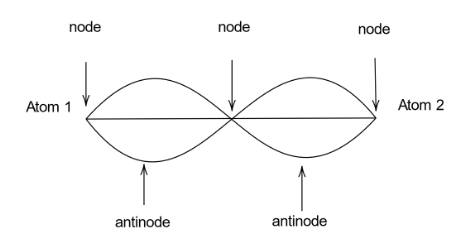
A standing wave having
A.
B.
C.
D.
Answer
402.9k+ views
Hint: We start by defining what standing waves are. We then move onto writing down the given data from the question. Then once we have done this, we define what wavelength, nodes and antinodes are. Then we see the number of nodes and antinodes in one wave and see if the number of nodes and antinodes match the number of nodes and antinodes in one wave. We can also draw a diagram to make sure what a wave having
Complete answer:
Let us start by defining what a standing wave is. A standing wave or a stationary wave is a kind of wave whose peak amplitude does not change in space but oscillates in time and the oscillations at different times are in phase.
We are given a standing wave having

We can see that the number of nodes and antinodes formed is equal to the number of the same in one wavelength. Hence the wavelength of the wave will be the same as the distance between the two atoms
Therefore, the right answer is option A.
Note: Here, the wavelength of a standing wave is defined with respect to the number of nodes and antinodes present. This helps in solving the problem more efficiently and easily. Wavelength can also be defined as the distance between two consecutive crests or two consecutive troughs. Crests and antinodes are two completely different ideas as, crests meet a crest; and then one-half cycle later, a trough will meet a trough whereas; an antinode will continue to vibrate between the positive and negative maximum values.
Complete answer:
Let us start by defining what a standing wave is. A standing wave or a stationary wave is a kind of wave whose peak amplitude does not change in space but oscillates in time and the oscillations at different times are in phase.
We are given a standing wave having

We can see that the number of nodes and antinodes formed is equal to the number of the same in one wavelength. Hence the wavelength of the wave will be the same as the distance between the two atoms
Therefore, the right answer is option A.
Note: Here, the wavelength of a standing wave is defined with respect to the number of nodes and antinodes present. This helps in solving the problem more efficiently and easily. Wavelength can also be defined as the distance between two consecutive crests or two consecutive troughs. Crests and antinodes are two completely different ideas as, crests meet a crest; and then one-half cycle later, a trough will meet a trough whereas; an antinode will continue to vibrate between the positive and negative maximum values.
Recently Updated Pages
Master Class 11 Economics: Engaging Questions & Answers for Success

Master Class 11 Business Studies: Engaging Questions & Answers for Success

Master Class 11 Accountancy: Engaging Questions & Answers for Success

Master Class 11 English: Engaging Questions & Answers for Success

Master Class 11 Computer Science: Engaging Questions & Answers for Success

Master Class 11 Maths: Engaging Questions & Answers for Success

Trending doubts
What are Quantum numbers Explain the quantum number class 11 chemistry CBSE

Why is steel more elastic than rubber class 11 physics CBSE

Explain why a There is no atmosphere on the moon b class 11 physics CBSE

In northern hemisphere 21st March is called as A Vernal class 11 social science CBSE

Balance the equation KOH + H2SO4 to K2SO4 + H2O class 11 chemistry CBSE

A dimensionless quantity A Never has a unit B Always class 11 physics CBSE




